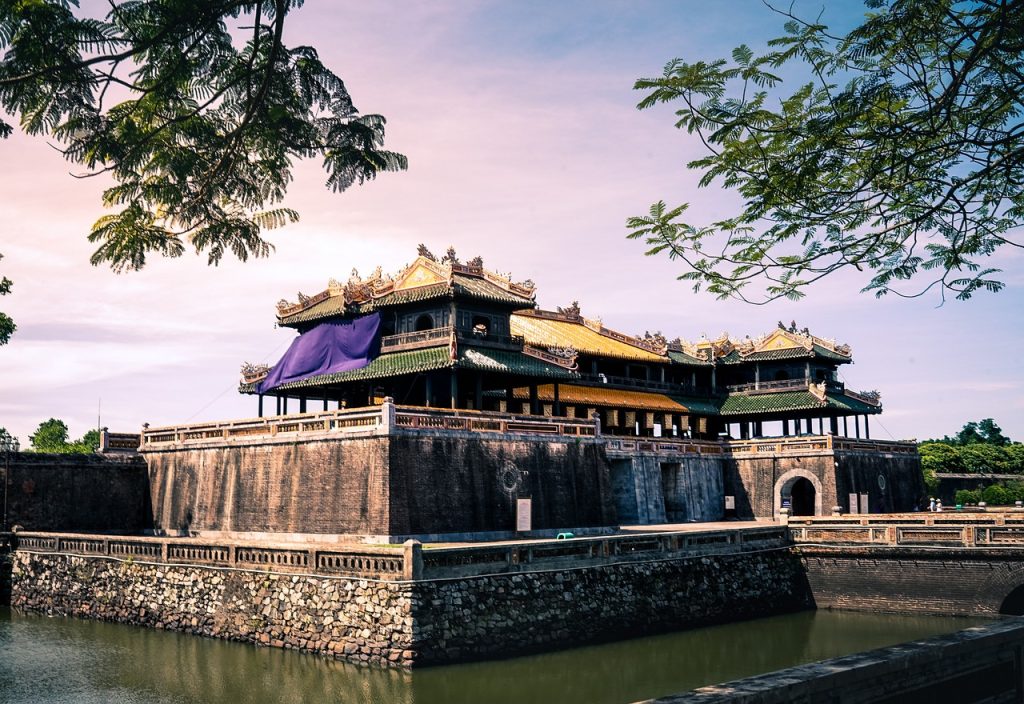Hue
Hue is the capital of Thua Thien Hue province in the central of Vietnam. The city served as the old imperial city and administrative capital of Nguyen dynasty from 1802 till 1945. The city of Hue lies along either side of the Perfume river. It is about 700km south of Hanoi and 1100 km north of Ho Chi Minh city. Located on the two banks of the Perfume River, north of Hai Van Pass, 105 km from Danang, 14 km from Thuan An Seaport and Phu Bai International Airport and 50 km from Chan May Port. The natural area is 71.68 km2 (27.68 sq mi) and the population in 2012 is estimated at 344,581 people. As of 2021, after the territorial expansion, the city has a total area of 265.99 km2 and the population is 652,572 people. In 1993, the complex of monuments in Hue was designated a UNESCO world heritage site.
The Imperial Citadel
Constructions of the moated citadel, which has a 10 km perimeter, was begun in 1804 by Emperor Gia Long on a chosen site by geomancers. The citadel was originally made of earth, but earlier in the 19th century, tens of thousands of workers labored to cover the ramparts, built in the style of the French military architect Vauban, with a layer of bricks 2m thick. The emperor’s official functions were carried out in the Imperial Enclosure, a citadel within a citadel with 6m high walls 2.5 km in length. The Imperial Enclosure has four gates, the most famous of which is Ngo Mon gate. Within the Imperial Enclosure is the Forbidden Purple City, which was reserved for the private life of the emperor.

The Royal Tombs
The tombs of the rulers of the Nguyen dynasty (1802-1945) are extravagant mausoleums constructed along the banks of the Perfume river. Situated between seven and sixteen km south of Hue, they are open from 6:30 am to 5:30 pm daily. Almost all the tombs, which are in walled compounds, were planned by the Nguyen emperors during their lifetimes. Many of the precious ornaments that once reposited in the tombs disappeared during Vietnam’s war. A list of the Royal Tombs includes of Tombs of Dong Khanh, Tomb of Tu Duc, Tomb of Thieu Tri, Tomb of Khai Dinh, Tomb of Minh Mang, Tomb of Gia Long which should be visited in your journey in Hue.
The Spirit of Hue
Each village and region of Vietnam is unique in its own way, an attribute the Vietnamese pride themselves on while equally extolling national unity. Therefore, it should be of no surprise that the spirit of Hue permeates its citizens and its history inspires great loyalty and ever-lasting memories. You will discover that spirit, on your sampan cruise up the Perfume river before the sun reaches its lofty perch, or in the late afternoon as it drops suddenly behind the mountain. Along the way you will pass the central marketplace, old French colonial homes, families living on houseboats, young men dredging the river bottom for sand, children swimming and playing, and the majestic mountains girdling the west.
The spirit of Hue emanates also from the singular cuisine of Hue. Highly recommened are Banh Khoai, a crepe with bean sprouts, shrimp, meat served with greens, starfruit and a special sauce, Bun Bo Hue, a beef noodle soup, Bun Thit Nuong, a dish of vermicelli noodles, greens and charbroiled meat served with fish sauce and Com Hen, rice and fresh mussels served with greens, sesame seeds and an indescribable sauce. Hue holds a special place in the hearts and minds of the Vietnamese people. Its very name evokes images of romanticism and high culture. These qualities already attract tourists to the area and increase economic growth and business possibilities.
Hue’s festival and music in here had developed. The court has Te Giao ceremony, Te Xa Tac, Nguyen Dan, Doan Duong, Van Tho, Dai Trieu, Thuong Trieu, Ban Soc, Truyen Lo, Duyet Binh… Common people have various festivals: Hon Chen, Cau Ngu, Sinh… Besides, there has ritual form of folk music such as: “tuong” Hue, dance of Hue…
The tourists will have opportunity to live in vivid space associated with the cultural festival of hundred years ago. A lot of foreign tourists are curious about Hue’s ritual royal music. Originated from 8 kinds of ritual music under Le dynasty, under Nguyen dynasty, it has improved into 2 kinds of music: “Dai nhac” and “Nha nhac”, which are really magnificent, and skillful. Those are only played on formal occasions. This city is proud to be the cradle of traditional music.
The Royal Refined Music was proclaimed by UNESCO as a Masterpiece of the Oral and Intangible Heritage of Humanity on December 1993. Traditional music has been preserved in the Hue city. Recently, we have established submissions for UNESCO recognized Hue royal music: Nha nhac is a masterpiece of intangible and cultural heritage.
Sapa Sunshine Travel
We bring an interesting and safe trip to customers, tourist services play an important role in the journey. We ensure that we will provide you with a high quality service to make your trip more and more comfortable and memorable.
Custom Links
*Home
*Sapa Tours
*All Tours
*Services
*Where To Travel
*Travel Services
Contact Us
- Sapa Town, Lao Cai, Vietnam
- +84968812644
- info@sapasunshinetravel.com
- www.sapasunshinetravel.com
- www.sapasunshinetravel.com.vn
Copyrights 2021 – All rights reserved
- ←
-
Email Us
Please send us an Email
